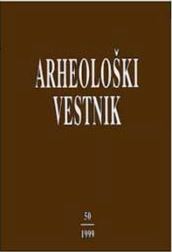Archaeological wood - its properties and research potential
Abstract
We studied basic physical and chemical properties of archaeological wood buried in the soil or preserved underwater in the Ljubljana Moor, Slovenia. The wood of oak (Quercus sp.), ash (Fraxinus sp.), alder (Alnus glutinosa), beech (Fagus sylvatica), and maple (Acer sp.) was selected from vertical piles from 5 prehistoric pile dwellings from the 3rd and from the 4th millennium BC. Moisture content above 500% and a drastic decrease in basic density indicated a very high degree of wood deterioration. Shrinkage was much higher than that in recent wood. Chemical analyses of ash-wood have shown a drastically increased amount of lignin and a reduced amount of cellulose and hemicelluloses. The results present basic knowledge for future planning of proper conservation treatment.
Downloads
References
ČUFAR, K., V. TIŠLER in Ž. GORIŠEK 2001, Some propertiesof waterlogged archaeological wood from prehistoric piledwellings. - V:
ICWSF 2001. The fifth international conferenceon the Development of Wood Science, Wood Technology andForestry in Ljubljana, Slovenia 5-7 September 2001, 25-31, Ljubljana.
FENGEL, D. in G. WEGENER 1989, Wood ChemistryUltrastructure Reactions. - Berlin, New York.
ROWEL, R. M. in R. J. BARBOUR 1990, Archaeological Wood. Properties, Chemistry, and Preservation. American ChemicalSociety. - Advances in Chemistry Series, Washington, DC.
VELUŠČEK, A. in K. ČUFAR 2002, Dendrokronološkeraziskave kolišč na Ljubljanskem barju - stanje 2001. -Arh. vest. 53, 59-67.
Downloads
Published
How to Cite
Issue
Section
License

This work is licensed under a Creative Commons Attribution-NonCommercial-NoDerivatives 4.0 International License.
Authors guarantee that the work is their own original creation and does not infringe any statutory or common-law copyright or any proprietary right of any third party. In case of claims by third parties, authors commit their self to defend the interests of the publisher, and shall cover any potential costs.
More in: Submission chapter





